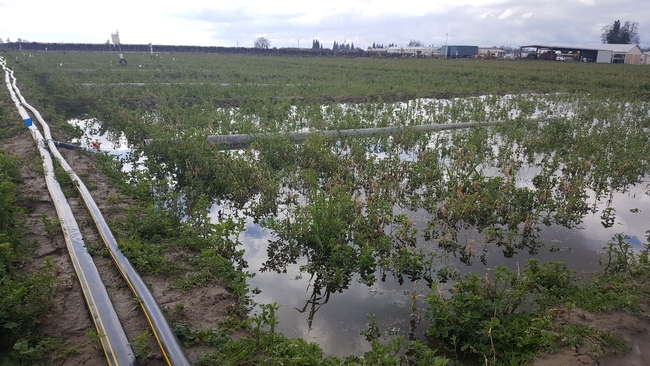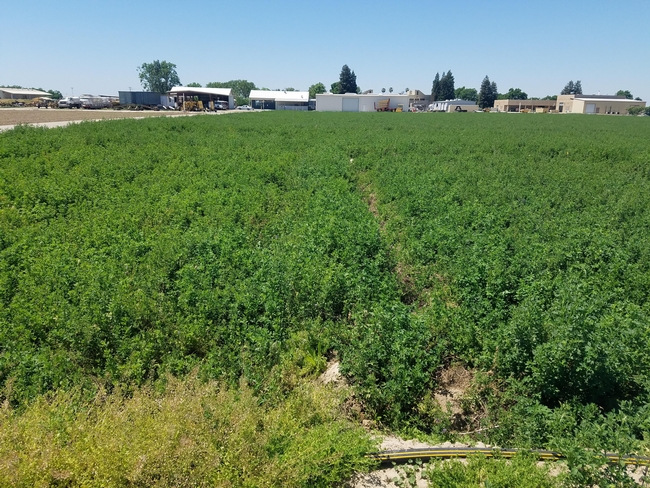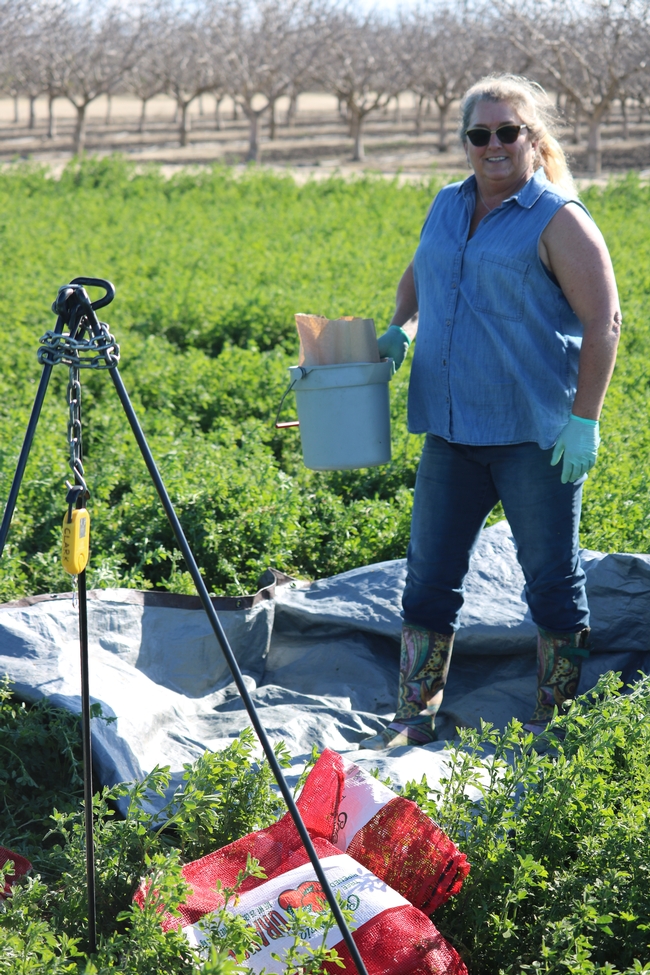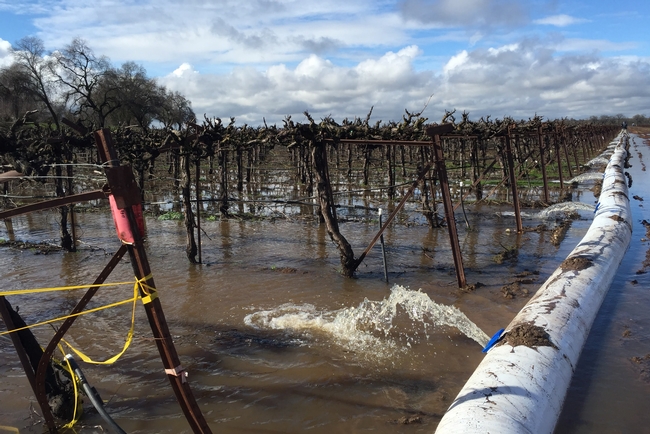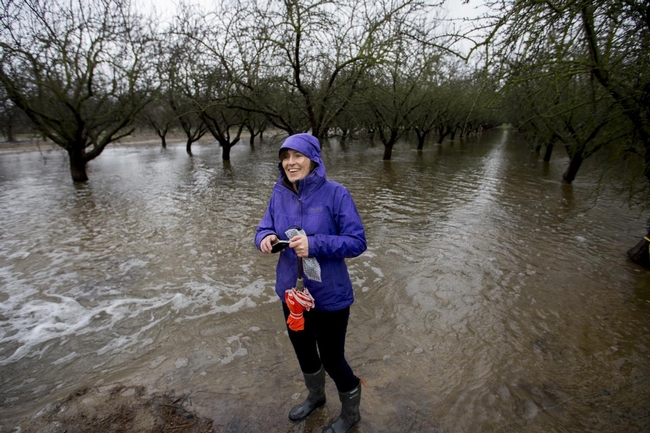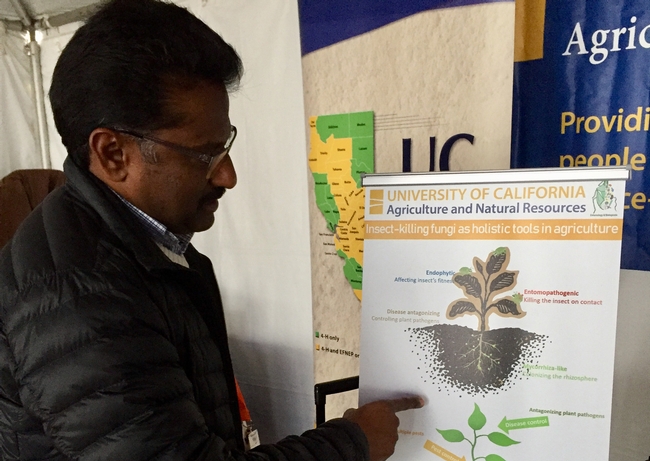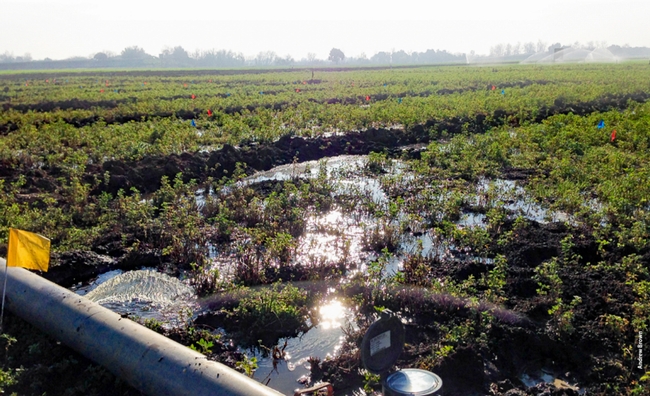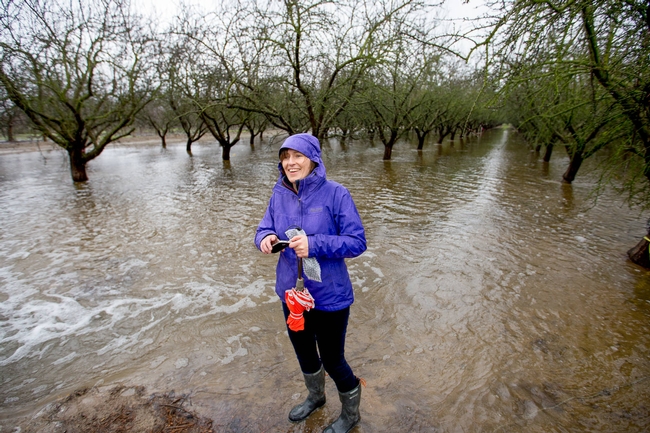Posts Tagged: Helen Dahlke
California groundwater could get recharging help from alfalfa farms
When California experiences drought due to a lack of rain and snow and the reservoirs don't fill up, people pump water out of the ground to meet their needs. But that practice has its limits, as groundwater aquifers -- underground layers of porous rock -- get depleted, similar to how water squeezes from a sponge.
Many of California's groundwater aquifers, especially in the San Joaquin Valley, are critically overdrafted. They are being depleted faster than they are being recharged by water from the surface percolating through the soil to groundwater. Overdrafting is a concern because California relies on groundwater aquifers as a water storage and supply resource. They must be protected to ensure water security in the future.
To direct surface water back into the aquifers, recharge basins are built, but they are limited in number and volume. Thinking of agricultural fields as potential recharge basins opens the possibility of increasing the number of locations where groundwater aquifers can be recharged.
Alfalfa is a crop that has a unique potential to support this practice because it is widely grown in the San Joaquin Valley and, in many cases, the plants are dormant or semi-dormant during the winter months. University of California researchers Helen Dahlke, Nick Clark and Khaled Bali are investigating how alfalfa copes with additional water in the winter and early spring, when snowmelt runoff occurs, for groundwater recharge.
“We hypothesized that water can be recharged in dormant and early regrowing established alfalfa fields successfully, and with little to no harm to the plants and the productivity as far as the farmer is concerned,” said Clark, a UC Cooperative Extension farm advisor.
The findings have shown great promise for recharging groundwater without negatively impacting alfalfa yield but may diminish quality. “You could do recharge in winter and then turn the water off completely and still get a cutting or two of alfalfa before the summer,” said Bali, a UCCE irrigation water management specialist.
Like Bali, Clark thinks alfalfa growers could use their fields for recharging groundwater while taking steps to limit loss of crop value.
“We did find that the practice of recharging groundwater in alfalfa fields can have a negative impact on the feed quality of the alfalfa when first harvested after the flooding,” Clark said.
“One big recommendation we have is that the alfalfa fields should be in their later years of production so if something disastrous happens, there is not so huge of investment return lost,” said Clark. “There is current research being conducted by UC Cooperative Extension specialists Dan Putnam and Khaled Bali examining practical solutions on the farm level that growers can implement to minimize the risk of damage to alfalfa when also flooding fields for groundwater recharge.”
Clark emphasized that farmers face incredibly complex water-management issues today. The drivers that influence their decisions reach far beyond the farm, so he collaborates with UC Davis professor Helen Dahlke, who studies integrated hydrologic sciences.
“It requires an approach from multiple disciplines to address that complexity,” he said. “Helen brings hydrological expertise, while I can focus on agronomy. So the information we provide is more holistic and relevant on a larger scale, but still practical and applicable for farmers.”
Grower input on the research findings has been critical to their success. “With their feedback, we were able to reform some of the project methodologies to achieve results that were even more relevant to the local conditions,” said Clark.
With the prolonged drought, innovations in groundwater recharge are becoming more crucial. Future research will continue to focus on how growers can use their land in multifaceted ways to improve California's water sustainability far into the future.
Targeted wintertime flooding on ag fields could improve the water supply for rural Californians
When droughts strike California, people who rely on shallow domestic wells for their drinking, cooking and washing water are among the first to feel the pain. Aquifers have become depleted from decades of overuse. Drilling deeper is an option for farmers, but prohibitively expensive for low-income residents in disadvantaged communities in the San Joaquin Valley.
A UC scientist believes managed aquifer recharge on agricultural lands close to populations with parched wells is a hopeful solution.
Helen Dahlke, professor in integrated hydrologic sciences at UC Davis, has been evaluating scenarios for flooding agricultural land when excess water is available during the winter in order to recharge groundwater. If relatively clean mountain runoff is used, the water filtering down to the aquifer will address another major groundwater concern: nitrogen and pesticide contamination.
“The recharge has the potential to clean up groundwater,” she said.
Five years ago, UC Cooperative Extension specialist Toby O'Geen developed an interactive map that identifies 3.6 million acres of California farmland with the best potential for replenishing the aquifer based on soil type, land use, topography and other factors. Dahlke and her colleagues analyzed the map and identified nearly 3,000 locations where flooding suitable ag land will recharge water for 288 rural communities, half of which rely mainly on groundwater for drinking water. The research was published by Advancing Earth and Space Science in February 2021.
“If we have the choice to pick a location where recharge could happen, choose those upstream from these communities,” Dahlke said. “Recharge will create a groundwater mound which is like a bubble of water floating in the subsurface. It takes time to reach the groundwater table. That bubble floating higher above the groundwater table might just be enough to provide for a community's water needs.”
Filling reservoirs under the ground
Many climate models for California suggest long-term precipitation amounts will not change, however, the winter rainy season will be shorter and more intense.
“That puts us in a difficult spot,” Dahlke said. “Our reservoirs are built to buffer some rain storms but are mainly built to store the slowly melting snowpack in the spring. In the coming years, all the water will come down earlier, snowmelt likely in March and April and more water in winter from rainfall events.”
She is working with water districts and farmers to consider a change in managing water in reservoirs.
“We want to think about drawing reservoirs empty and putting the water underground during the fall and early winter. Then you have a lot of room to handle the enormous amounts of runoff we expect when we have a warm atmospheric river rain event on snow in the spring,” she said. “However, farmers are hesitant. They like to see water behind the dams.”
Interest in groundwater banking has been lifted with the implementation of the 2014 Sustainable Groundwater Management Act (SGMA). The law requires governments and water agencies to stop overdraft and bring groundwater basins into balanced levels of pumping and recharge by 2040. Before SGMA, there were no statewide laws governing groundwater pumping and groundwater was used widely to irrigate farms when surface supplies were cut due to drought.
“For some of the drought years, overdraft was estimated to be as high as 9 million acre-feet a year,” Dahlke said.
Dahlke believes wintertime flooding for groundwater recharge can help water districts meet SGMA rules. “We have to do anything we can to store any surplus water that becomes available to save it for drier times and our aquifers provide a huge storage for that,” she said.
Farming impacts
The Dahlke lab is collaborating with UC Agriculture and Natural Resources farm advisors and specialists and with scientists at other UC campuses to learn about agronomic impacts of flooding a variety of agricultural crops, including almonds, alfalfa and grapes.
In the San Joaquin Valley, UC Cooperative Extension irrigation specialist Khaled Bali led an intermittent groundwater recharge trial on alfalfa. The researchers applied up to 16 inches per week with no significant impact on alfalfa yield.
“You could do groundwater recharge in winter and then turn the water off completely and still get a cutting or two of alfalfa before summer,” he said.
This past winter, Dahlke was prepared to flood 1,000 acres of land with water from the Consumnes River. Even though winter 2020-21 was another drought year, the research will go on. Her team was able to flood a 400-acre vineyard and, in collaboration with scientists from UC Santa Cruz, deploy sensors in the field to measure infiltration rates to better understand whether sediment in the flood water could clog pores in the soil. Her team also collaborates with Ate Visser of Lawrence Livermore National Laboratory in using isotope and noble gas data to determine the groundwater age and flow.
The Dahlke Lab's groundwater banking project has planned more studies in groundwater basins across the state to close knowledge gaps on suitable locations, technical implementation and long-term operation. They also plan to address operational, economic and legal feasibility of groundwater banking on agricultural land.
ANR in the news March 1-11
Western Innovator: Putting biologicals to work
(Capital Press) Padma Nagappan, March 11
Early in life, Surendra Dara decided that no matter which field he chose, he needed to make an impact on it. Always interested in science, he chose agriculture and specialized in entomology.
“It attracted me because it dealt with arthropods and there are a lot of physiological similarities to the human world,” Dara said. “It was also critical for growing food and feeding humans.”
Dara is now an entomopathologist with the University of California's Division of Agriculture and Natural Resources in San Luis Obispo, and has an established reputation for exploring innovative options to control pests using microbials as biological controls, and showing growers how they can also help with plant growth, drought resistance and fighting diseases.
Group linked to Ocasio-Cortez seeks ag input after Green New Deal backlash
(Politico) Helena Bottemiller Evich, March 11
After watching that drama unfold, Frank Mitloehner, a leading scientist on agricultural emissions at the University of California, Davis, was thrilled when two outreach staff affiliated with AOC's network reached out to set up a call to discuss the potential for climate mitigation efforts in agriculture. The call, held earlier this month, lasted more than an hour, Mitloehner said.
“I was very glad to inform of what I know, and they were very receptive to it,” Mitloehner said on Agri-Talk last week. During the segment, he urged agricultural producers to not dismiss the left-wing climate effort.
Sudden surge in an unusual crime in Fresno County: Goat theft
(LA Times) Hannah Fry, March 11, 2019
…Picquette's two sons have been raising goats for the last five years as a 4-H project. Losing their animals has been especially hard for the boys, Picquette said, adding that they had planned to use money won during competitions to pay for college.
“They feel very violated. They don't understand how somebody could just come and take something they worked so hard for,” she said. “The bond we have with the goats is incredible. I'm just heartbroken. I don't know if they're scared or hungry. … They've always been treated so well.”
https://www.latimes.com/local/lanow/la-me-ln-fresno-goat-theft-20190311-story.html
California's ambitious plan to stop deadly wildfires may not be enough, experts say
(SF Chronicle) Kurtis Alexander, March 9
… “It's not fair to say that fuel treatments won't do any good,” said Max Moritz, a UC Cooperative Extension wildfire specialist at UC Santa Barbara. “It may provide some protection in some places. But most of us studying this agree that you can't just do this and (expect to) make much headway.”
The plan by the California Department of Forestry and Fire Protection, or Cal Fire, comes at the request of Gov. Gavin Newsom. On his second day in office, Newsom asked the agency to develop a proposal to address the increasingly destructive fire seasons that have rattled the state and are expected to worsen with climate change.
…In the meantime, many researchers say the most effective approach to fire protection is not in the forests, but in communities. They recommend making homes more resistant to fire with hardier construction materials, and clearing the vegetation around them.
“You have to address the home vulnerabilities themselves,” said Moritz at UC Santa Barbara. “If you don't, you're just not going to make a lot of progress on fire.”
After more than 140 years, a massive fig tree gracing the plaza where Los Angeles was founded collapses
(LA Times) Matthew Ormseth, March 9
… The four figs were planted at El Pueblo by agriculturalist and City Councilman Elijah Hook Workman, KCET reported in 2013. The Ficus macrophylla was brought from Australia to Southern California in the 1860s and 1870s, probably to provide shade and ornamentation, said Donald Hodel, a horticulture advisor for the University of California's Cooperative Extension.
Hodel described the Moreton Bay fig as a commanding breed of tree with an enveloping canopy that threw plenty of shade.
His reasons for admiring the Moreton Bay fig: “Their grandeur; their size — they have an imposing habit; their root structure is incredible; the spreading nature of their branches.”
Hodel said he last saw the El Pueblo figs about six years ago.
“I wasn't too impressed by their health or their size, considering they're 140-something years old,” he said.
https://www.latimes.com/local/lanow/la-me-pueblo-tree-falls-20190309-story.html
California's 2018 Was the Worst Ever Recorded for Wildfires
(Gizmodo) Tom McKay, March 9
University of California, Santa Barbara UC Cooperative Extension wildfire researcher Max Moritiz told the Chronicle, “It's not fair to say that fuel treatments won't do any good. It may provide some protection in some places. But most of us studying this agree that you can't just do this and (expect to) make much headway.”
https://earther.gizmodo.com/californias-2018-was-the-worst-ever-recorded-for-wildfi-1833180368
4-H leader who taught lost Benbow girls outdoor skills being flown to Washington, DC for recognition
Kym Kemp, March 7
When Leia Carrico, age 8, and her sister, Caroline, age 5, disappeared into the woods around their home near Benbow on March 1, the whole nation held its breath for the next 44 hours until they were found. But, though their 4-H leaders were worried, too, they say they also knew the girls had something many other children don't–they had survival skills from a class taught by their Outdoor Adventures 4-H project leader, Justin Lehnert.
Lehnert is being honored in Washington, DC, on Tuesday for his role in teaching Leia and Caroline outdoor skills.
Researchers highlight plan to eat healthy on a budget
(Consumer Affairs) Kristen Dalli, March 7
Following a healthy diet can come with a hefty price tag, but a team of researchers has outlined a way for consumers to stick to a healthy diet -- and also stick to their budgets.
According to the team, consumers -- and their families -- can have healthy meals if they focus on buying items in bulk and planning meals in advance.
“This study determines the likelihood that families living in low-income households could create meals that meet the USDA dietary guidelines presented in MyPlate nutrition education materials,” said researcher Karen M. Jetter, PhD. “In addition to food cost, the other factors considered were access to stores, time for meal preparation, and whether the menus included culturally appropriate foods.”
Healthy eating is possible on a limited budget, study shows
Study: Eating healthy on a budget is possible
https://www.upi.com/Study-Eating-healthy-on-a-budget-is-possible/9951551904010/
Eating Healthy Is Possible on a Small Budget, Says Study
https://www.askmen.com/news/sports/eating-healthy-is-possible-on-a-small-budget-says-study.html
Sorry, Alexandria Ocasio-Cortez, but “farting cows” aren't the problem
(New Food Economy) Sam Bloch, March 7
…As it turns out, neither side was accurate. Republicans are likely to continue linking Green New Deal priorities to a supposed hamburger ban. But if you don't hear about cow farts anymore from AOC, it may not be because of GOP criticism. Frank Mitloehner, an animal scientist and air quality specialist at the University of California, Davis, insists cattle flatulence isn't the problem it's made out to be, and says he helped set the record straight.
Here's what seems to have happened. On February 4, shortly before Ocasio-Cortez announced the Green New Deal, she was speaking to school children in Queens, New York. When one asked how they could “combat” climate change, Ocasio-Cortez offered two practical options—stop using disposable razors, and skip meat and dairy for one meal.
Mitloehner tweeted at her.
“Dear @AOC: we all try to help the climate,” he wrote. “However, the two options you offered have low impacts compared to the 800lb gorilla, which is to reduce fossil fuel use. About ? of greenhouse gas emissions in the US stem from transport and energy prod&use. Meat/milk = 4 % of total GHG,” referring to findings in a recent EPA report.
… “I give her team a lot of credit for reaching out,” Mitloehner says. “If we really are serious about making a difference in carbon emissions, you cannot do this without agriculture involved.”
California supplies a quarter of the world's sunflower seeds
(Capital Press) Padma Nagappan, March 7
…Khaled Bali is a University of California Department of Agriculture and Natural Resources statewide water and irrigation specialist who has been working since 2016 on a four-year trial on sunflower varieties.
He was asked by the University of Georgia to help ascertain which varieties were drought resistant. He chose to conduct his trial in the low desert region of the Imperial Valley, since it gets little rain during the growing season between February when it's planted, and June when it's harvested. This would make it easier to control and measure the actual water applied to the crop varieties.
“We're looking at 285 varieties of sunflowers, to see which ones do well under stress,” Bali said. He has tested different plantings each growing season for the past three years, and will finish the trial this year.
https://plantingseedsblog.cdfa.ca.gov/wordpress/?p=17375
Livestream coverage of fire protection panel discussion in Nevada City
(Sierra Sun) March 7
…Following the films, the community is invited to join an ongoing conversation around the new reality of living with fire in the wildland urban interface. Panelists represent a diverse cross-section of the wildfire prevention community including: Cal Fire, Fire Safe Council of Nevada County, Nevada County Office of Emergency Services, Nevada County Resource Conservation District, Pacific Gas and Electric Company, Tahoe National Forest and University of California Cooperative Extension. The panel discussion will be moderated by YubaNet Co-founder Pascale Fusshoeller. [Kate Wilkin, UCCE fire advisor, participates on the panel in the last hour of the video.]
Bees, blooms off to slow start
(Western Farm Press) Logan Hawkes, March 6
…This year, almond bloom started around a normal time, with some early varieties showing a few open flowers in the first week of February,” reported Franz Niederholzer, UCCE farm advisor for Colusa, Sutter, and Yuba Counties. “For most of the month bloom progressed very slowly,”
By the middle of February, he says, “bloom for Nonpareil was at least two weeks behind, and bee hours were limited until the last week of the month. Last year, between Feb 1-20, we accumulated 130 bee hours of good honey bee flying weather [55 F., no rain, and wind less than 10 mph]. For the same interval this year, we had around 10 hours and only six of those occurred with open flowers in the orchard.”
On the positive side of the slow start, Niederholzer says, the colder weather tends to suppress activity of key bloom diseases such as blossom brown rot and anthracnose. “However, cold weather at bloom was conducive to blossom blast (pseudomonas) bacteria, and some growers were considering adding materials to their normal bloom fungicides with bactericide activity.”
https://www.farmprogress.com/tree-nuts/bees-blooms-slow-start
Wet winter aids groundwater replenishment
(Ag Alert) Christine Souza, March 6
… Helen Dahlke, a hydrology expert and professor with the University of California, Davis, Department of Land, Air and Water Resources, has been working with farmers, studying on-farm groundwater recharge locations and suitability for various crops.
"In many regions, we can definitely do more actively recharging our groundwater aquifers," said Dahlke, who currently has trials on alfalfa at the UC Kearney Agricultural Center. "It really depends on what region, how much surface water is available for recharge, what kind of sediment structure or hydrogeology we have underneath and whether it's suited for conveying large amounts quickly."
Despite abundant precipitation in recent weeks, she said the timing is not the best for studying impact of recharge on certain crops.
"We prefer on-farm recharge to happen in January and February, just because that is considered the dormancy season for most crops," Dahlke said. "With almond trees already blooming, often there is a greater risk of applying water on those crops."
She said recent precipitation has helped groundwater recharge overall, but there is "very little way of estimating how much it is helping."
http://www.agalert.com/story/?id=12797
Drip irrigation improves yields of Imperial sugar beets
(Ag Alert) Padma Nagappan, March 6
Halfway through a two-year irrigation trial to test furrow irrigation versus drip on sugar beet in California's Imperial Valley, Ali Montazar is looking for ways to boost yields with as little water consumption as possible in a region where furrow irrigation is the common practice.
Montazar, irrigation and water management advisor with the University of California department of agriculture and natural resources (UCANR) in Imperial County, is comparing and evaluating sugar beets for crop water use, sugar percentage, and yield, using both furrow and drip, since growers are now thinking of switching to subsurface drip.
Preliminary results from year one of the trial show that yield and crop water use are better with drip. Yield was 21 percent higher, and water use was a few points lower.
http://www.agalert.com/story/?id=12782
NFU says “No” to Green New Deal
(DTN) Jerry Hagstrom and Chris Clayton, March 6
Frank Mitloehner, an animal-science professor and air-quality Extension specialist at the University of California-Davis, reached out to Ocasio-Cortez's team about agriculture and the Green New Deal after seeing social media posts late last month about “farting cows” that drew a great deal of attention.
“I appreciate her interest in climate-change mitigation, but the 800-pound gorilla is the use of fossil fuels, and I told her that even the notion of cow flatulence makes this whole thing sound silly, and that's not what we need this discussion to be,” Mitloehner told DTN in an interview.
From Farting Cows to More Beans; Anti-Livestock Claims Fall Short
(AgriTalk) Jennifer Shike, March 5
The EAT-Lancet Commission on Food, Planet, Health is backpedaling as industry leaders and scientists poke holes in its “planetary diet” released in mid-January that is supposed to improve human health and planet health.
Air Quality Extension Expert Frank Mitloehner of the University of California Davis joined Chip Flory on AgriTalk Monday to discuss EAT-Lancet and Green New Deal in more depth.
4-H instructor who taught NorCal sisters how to survive in wilderness speaks out
(ABC7) Dion Lim, March 4
ABC7 News spoke exclusively to the 4-H instructor who taught two young girls the life-saving skills they needed to survive a weekend lost in the woods.
… Their mom, Misty Carrico, says she's not sure her daughters would have survived, if not for their 4-H program.
"The group leader Justin has taught them fire making skills and wilderness survival skills."
Justin Lehnert, the girls' 4-H leader, said, "I'm ecstatic that they did the job that they did. They're very strong girls and they stayed calm."
… Nine-year-old Caroline Gelormini has been a member of the San Bruno-South San Francisco 4-H Program for five years. Thanks to 4-H, she feels like she'd have a shot at surviving in the woods too.
Ocasio-Cortez Seeks Ag Data on Green New Deal
(Drovers) John Herath, March 4
When freshman congresswoman Alexandria Ocasio-Cortez released her Green New Deal plan, social media lit up with talk of her plan's mentions of “farting cows.” That drew the attention of agriculture's preeminent expert on air quality, Dr. Frank Mitloehner of the University of California at Davis, who tweeted back at the congresswoman.
“I don't know whether my tweet was the reason, but a few hours after I tweeted her, all mentioning of cow flatulence were taken off the web pages and of all social media outlets and was never to be heard again,” Mitloehner told Chip Flory on the AgriTalk Radio Show Monday.
https://www.drovers.com/article/ocasio-cortez-seeks-ag-data-green-new-deal
2 missing Humboldt County girls found — ‘absolute miracle
(SF Chronicle) Michael Cabanatuan, March 3
…Little additional information was available on how the girls went missing or how they survived, but Honsal said they had been trained in outdoors survival as members of a 4-H program.
https://www.sfchronicle.com/news/article/Absolute-miracle-as-missing-Humboldt-County-13659375.php
Organic farm east of Denair does its part on climate change. It's getting an award
(Modesto Bee) John Holland, March 2
…The family won in the farmer/rancher category of the Climate Leadership Awards. The others:
- Researcher: Tapan Pathak of the University of California Cooperative Extension in Merced, who helps farmers adapt to climate change.
- Policymaker: Ken Alex, who was director of former Gov. Jerry Brown's Office of Planning and Research
- Legislative staff: Brett Williams, office of Assemblywoman Jacqui Irwin, D-Thousand Oaks
- Agricultural professional: Ruth Dalquist-Willard, UC Cooperative Extension, Fresno
https://www.modbee.com/news/article226956529.html
Eructation Inflation: Greenhouse Gas Emissions of Livestock
(Science for the Rest of Us) March 1
Put your nerd hat on -- we cover a lot of ground in this fast-paced discussion with Dr. Frank Mitloehner of the University of California-Davis about the greenhouse gas emissions associated with the meat and dairy we consume. We consider how livestock emissions compare to other sectors of the US and global economies, the carbon footprint of vegetarian diets and what is the most effective way to reduce individual carbon emissions.
Keeping the Carbon Footprint of Livestock in Perspective
(AgNet West) Brian German, March 1
…“It is irresponsible and it's misguiding the public to believe that the true sources of pollution are downplayed, and the impacts of animal agriculture are grossly inflated,” said Dr. Frank Mitloehner, Professor and Air Quality Specialist in Cooperative Extension in the Department of Animal Science at the University of California, Davis.
Flooding alfalfa fields has high potential for groundwater recharge
A rigorous field study in two California climate zones has found that alfalfa can tolerate very heavy winter flooding for groundwater recharge. The research was published online Jan. 16 in California Agriculture journal.
The alfalfa research is the latest in a series of projects studying the effects of using land planted with permanent crops – including almond orchards and vineyards – to capture and bank winter storm water. Such projects have great promise but also require collaboration across multiple jurisdictions and agencies. UC Agriculture and Natural Resources vice president Glenda Humiston has made groundwater recharge on working lands and open spaces a division priority and is working with water and land use leaders around the state to facilitate it through policy recommendations and cross-agency collaboration.
Groundwater is a critical water reserve in California, particularly during droughts when surface water supplies are low. Water slowly filled California's aquifers over tens of thousands of years. Beginning in the early 20th century and continuing in the present day, groundwater has been consistently withdrawn at a higher rate that it can be replenished naturally. In 2014, the California Legislature enacted the Sustainable Groundwater Management Act, which requires all critically overdrafted groundwater basins to have a groundwater sustainability plan in place by 2020.
Flooding agricultural land during the winter, when surplus surface water is often available, is one promising strategy for replenishing overdrafted aquifers.
View a four-minute video about on-farm flooding for groundwater recharge on the UCTV Sustainable California channel. In the video, Professor Helen Dahlke discusses the work she and her fellow UC Davis researchers, UC Cooperative Extension advisors and specialists, and California farmers are undertaking to test the impacts of irrigating almond orchards in the winter to recharge groundwater.
For the alfalfa flooding research, UC Davis and UC Cooperative Extension scientists flooded two established alfalfa stands, one near Davis and one in the Scott Valley, Siskiyou County, during the winters of 2015 and 2016. The sites were selected because the soils in those areas have relatively high water percolation rates.
“We found that most of the applied water percolated to the groundwater table,” wrote lead author Helen Dahlke, integrated hydrologic science professor at UC Davis.
The alfalfa endured saturated conditions in the root zone for a short time, but the yield loss was minimal.
Dahlke and her co-authors – USDA Natural Resources Conservation Service soil scientist Andrew Brown, and UC Cooperative Extension specialists Dan Putnam and Toby O'Geen and the late UCCE advisor Steve Orloff – noted that the positive results of the alfalfa trial show tremendous potential for the state's groundwater basins. Using an index created by O'Geen that identifies the locations of California soils suitable for on-farm groundwater recharge, the scientists calculated the potential groundwater recharge. If all the suitable alfalfa acreage were flooded with six feet of winter water, and assuming 90 percent percolates past the root zone, it would be possible to bank 1.6 million ac-ft. of groundwater per year.
“For reference, the Oroville reservoir, second largest in the state, has a storage capacity of 3.5 million ac-ft.,” Dahlke wrote.
Leigh Bernacchi, program coordinator of UC Water at UC Merced, interviewed Helen Dahlke to get more details on groundwater recharge strategies for California. Read the Q&A on the UC Water Center website.
Additional reading:
- Map identifies farmland with potential for groundwater recharge
- Flooding farms in the rain to restore groundwater
- On-farm flood capture could reduce groundwater overdraft in Kings River Basin
- Desperate Times Call for Sensible Measures: The Making of the California Sustainable Groundwater Management Act
$1.6M from NSF to Study Water, Land Use in Disadvantaged Communities
The National Science Foundation has awarded $1.6M to UC Davis to analyze the complex relationships between surface water and groundwater supply, agricultural land use and the economic well-being of rural, disadvantaged communities.
The project is led by principal investigator Helen Dahlke, an associate professor in the UC Davis Department of Land, Air and Water Resources. The team will develop models to help guide decision-making regarding water management and land use in the state.

Helen Dahlke studies how groundwater is used and replenished in California. (Tiffany Kocis/UC Davis)
While the newly funded project focuses on the Tulare Basin in California's Central Valley, it is expected to provide new insights for other regions of the United States facing similar issues involving economic and water security.
The broader impacts of the project focus on helping local disadvantaged communities participate in the governance of water resources. This includes forming “water schools” and engaging K-12 students from under-represented groups in science and policy issues.
The project will also provide interdisciplinary research education and training for graduate and undergraduate students, who will be involved in all aspects of the research and community engagement activities.
The project is supported by the NSF Dynamics of Coupled Natural and Human (CNH) Systems Program. The award is one of nine the program awarded across the nation this week, totaling $13 million.
“These awards demonstrate the importance of understanding the connectedness of nature and society in studying the effects of environmental change and socioeconomic stress,” said CNH program director Liz Blood of NSF.
Co-PIs on the research team include Jon Herman in the UC Davis Department of Civil and Environmental Engineering; Anne Visser and Clare Gupta in the UC Davis Department of Human Ecology; Rebecca Teasley from the University of Minnesota, Duluth; and Laurel Firestone from the nonprofit Community Water Center.
More information
Flooding Farms in the Rain to Restore Groundwater
Kat Kerlin writes about the environment for UC Davis Strategic Communications. Follow her at @UCDavis_Kerlin.

